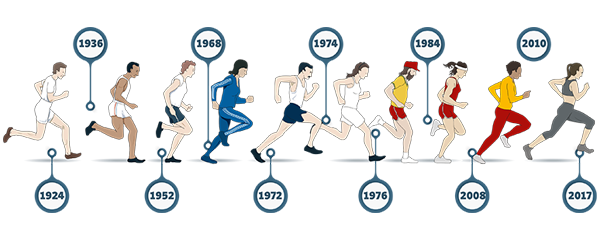Capa History of running shoes
The history of running shoes with Capa™
Capa™ is used in top-of-the-line running shoes, satisfying even the pickiest runners. And it has been used in this way for many decades.

Capa™ is used today in top-of-the-line running shoes, satisfying even the most demanding runners:
- Outsole – increasing flexibility, wear resistance and overall durability
- Adhesive – for structure and stability
- Heel counter (in the rear of the shoe) – adding stability and improving durability
- Increasing resilience – adding spring and bounce, improving the running experience
While running barefoot has been the rule throughout the ages, people have continuously tried various footwear to run faster – low weight and traction being the main objectives.
From the 1970s, cushioning and bounce-back have been essential. What we today recognize as running shoes were born in the late 1890s and took off at the other side of the turn of the century.
1924
In the 1924 Paris Olympics, Harold Abrahams wins the 100-meters gold in JW Foster “running pumps”. The same year, the father of the modern running shoe, Adolf “Adi” Dassler, starts his first company.
1936
Jesse Owens performs his mind-blowing feat, winning four gold medals in the Berlin Olympics using shoes made by Dassler. They are made of glove leather, with heel and toe reinforcements, and six long spikes.
1952
Marjorie “the Lithgow Flash” Jackson lowers the 100-meters world record time to 11.4. Also in 1952, Dassler’s company Adidas (founded in 1949) develops the first running shoes with changeable spikes.
1968
The first so-called jogging shoe hits the market – the Adidas Achill, with a wedge cushioning system. Formerly known as “roadwork”, the term “jogging” was increasingly used in the 1960s.
1972
Nike co-founder Bill Bowerman designs the Cortez, the first running shoe with full-length foam midsole. Frank Shorter, winner of the Summer Olympics marathon, helped inspire the 1970s American running boom.
1974
Kathrine Switzer is the women’s winner of the New York City Marathon. Her great work opened the door for female marathon runners. Also in 1974, Bill Bowerman – in a waffle iron – cooks up the Nike Waffle Trainer, the mother of all later running shoes.
1976
The Brooks Vantage is the first mass-produced running shoe that takes running style (neutral, pronation and supination) into account. Three years later, Forrest Gump sets out on his 3 years, 2 months, 14 days and 16 hours crisscrossing of the US.
1984
One of the first smart shoes, the cutting-edge Adidas Micro Pacer marries running shoes and electronics. It features a toe-area sensor and a microcomputer that calculates distance, pace and calorie burn.
2008
Adapting to environment-friendly macro trends, BioMoGo, by Brooks, is the first bio-degradable athletic shoe midsole, which breaks down 50 times faster than traditional cushioning material.
2010
With a completely new look, Reebok introduces the space-age ZigTech series foamless soles with horizontal tubular structures for cushioning and energy return.
2017
Manufacturers are using space technology to collect and analyze data to come up with “the next big thing”. Materials and technology development continues in all parts of the shoes. Knit, sock-like uppers are popular to enhance the feel.
The future
Runners will very likely be looking for even more personalized rides, something that 3D printing and plastics engineering can provide. Around the next curve, we will see more apps and electronics as well as recycled and sustainable materials. And there will be no peace in the manufacturers’ “energy-return war”.